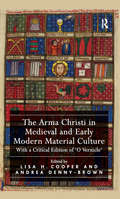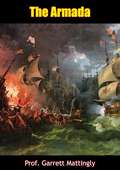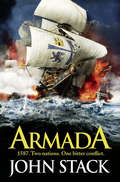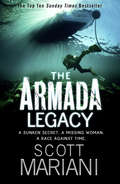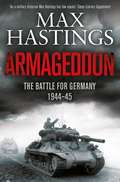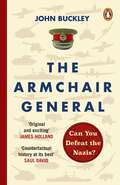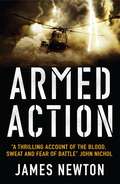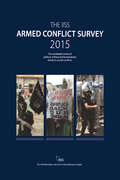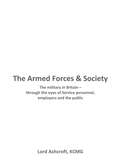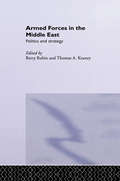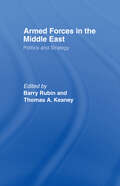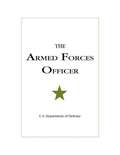- Table View
- List View
The Arma Christi in Medieval and Early Modern Material Culture: With a Critical Edition of 'O Vernicle'
by Lisa H. Cooper Andrea Denny-BrownThe Arma Christi, the cluster of objects associated with Christ’s Passion, was one of the most familiar iconographic devices of European medieval and early modern culture. From the weapons used to torment and sacrifice the body of Christ sprang a reliquary tradition that produced active and contemplative devotional practices, complex literary narratives, intense lyric poems, striking visual images, and innovative architectural ornament. This collection displays the fascinating range of intellectual possibilities generated by representations of these medieval ’objects,’ and through the interdisciplinary collaboration of its contributors produces a fresh view of the multiple intersections of the spiritual and the material in the Middle Ages and Renaissance. It also includes a new and authoritative critical edition of the Middle English Arma Christi poem known as ’O Vernicle’ that takes account of all twenty surviving manuscripts. The book opens with a substantial introduction that surveys previous scholarship and situates the Arma in their historical and aesthetic contexts. The ten essays that follow explore representative examples of the instruments of the Passion across a broad swath of history, from some of their earliest formulations in late antiquity to their reformulations in early modern Europe. Together, they offer the first large-scale attempt to understand the arma Christi as a unique cultural phenomenon of its own, one that resonated across centuries in multiple languages, genres, and media. The collection directs particular attention to this array of implements as an example of the potency afforded material objects in medieval and early modern culture, from the glittering nails of the Old English poem Elene to the coins of the Middle English poem ’Sir Penny,’ from garments and dice on Irish tomb sculptures to lanterns and ladders in Hieronymus Bosch’s panel painting of St. Christopher, and from the altar of the Sistine Chapel to the printed prayer books of the Reformation.
The Arma Christi in Medieval and Early Modern Material Culture: With a Critical Edition of 'O Vernicle'
by Lisa H. Cooper Andrea Denny-BrownThe Arma Christi, the cluster of objects associated with Christ’s Passion, was one of the most familiar iconographic devices of European medieval and early modern culture. From the weapons used to torment and sacrifice the body of Christ sprang a reliquary tradition that produced active and contemplative devotional practices, complex literary narratives, intense lyric poems, striking visual images, and innovative architectural ornament. This collection displays the fascinating range of intellectual possibilities generated by representations of these medieval ’objects,’ and through the interdisciplinary collaboration of its contributors produces a fresh view of the multiple intersections of the spiritual and the material in the Middle Ages and Renaissance. It also includes a new and authoritative critical edition of the Middle English Arma Christi poem known as ’O Vernicle’ that takes account of all twenty surviving manuscripts. The book opens with a substantial introduction that surveys previous scholarship and situates the Arma in their historical and aesthetic contexts. The ten essays that follow explore representative examples of the instruments of the Passion across a broad swath of history, from some of their earliest formulations in late antiquity to their reformulations in early modern Europe. Together, they offer the first large-scale attempt to understand the arma Christi as a unique cultural phenomenon of its own, one that resonated across centuries in multiple languages, genres, and media. The collection directs particular attention to this array of implements as an example of the potency afforded material objects in medieval and early modern culture, from the glittering nails of the Old English poem Elene to the coins of the Middle English poem ’Sir Penny,’ from garments and dice on Irish tomb sculptures to lanterns and ladders in Hieronymus Bosch’s panel painting of St. Christopher, and from the altar of the Sistine Chapel to the printed prayer books of the Reformation.
Armada: The Spanish Enterprise and England's Deliverance in 1588
by Colin Martin Geoffrey ParkerThe definitive history of the Spanish Armada, lavishly illustrated and fully revised“Will surely become the definitive account.”—Stephen Brumwell, Wall Street Journal In July 1588 the Spanish Armada sailed from Corunna to conquer England. Three weeks later an English fireship attack in the Channel—and then a fierce naval battle—foiled the planned invasion. Many myths still surround these events. The genius of Sir Francis Drake is exalted, while Spain’s efforts are belittled. But what really happened during that fateful encounter? Drawing on archives from around the world, Colin Martin and Geoffrey Parker also deploy vital new evidence from Armada shipwrecks off the coasts of Ireland and Scotland. Their gripping, beautifully illustrated account provides a fresh understanding of how the rival fleets came into being; how they looked, sounded, and smelled; and what happened when they finally clashed. Looking beyond the events of 1588 to the complex politics which made war between England and Spain inevitable, and at the political and dynastic aftermath, Armada deconstructs the many legends to reveal why, ultimately, the bold Spanish mission failed.
The Armada
by Prof. Garrett MattinglyWINNER OF THE SPECIAL CITATION FROM THE PULITZER PRIZE COMMITTEEIn 1588, the English fleet defeated the mighty Spanish Armada in the sea battle that author Garrett Mattingly refers to as “the focus of the first great international crisis in modern history.”Winner of 1960 Pulitzer Prize and a model history as important to the scholar as it is engrossing for the general reader, Mattingly’s 1959 book The Armada is the definitive story of that battle and its meaning.
Armada
by John StackThe author of the Masters of the Sea series, is back with a standalone battle book that will blow all others out of the water.
The Armada Boy: A gripping detective thriller that will keep you guessing until the very end (Wesley Peterson #2)
by Kate EllisFour centuries, two murders, one motive...When the body of US army veteran Norman Oppenheim is discovered in the ruins of an old chapel, Tradmouth quickly becomes the scene of a disturbing murder inquiry for DS Wesley Peterson.As the investigation deepens, DS Wesley and his team soon realise that there's no shortage of motives amongst the residents of Tradmouth and with the list of suspects growing every day, is there anyone left that they can trust?The stakes are raised when a near identical crime comes to light but there's just one problem - it happened over 400 years ago.As DS Wesley pieces together new evidence with old, he soon discovers a horrific truth that has remained buried deep in the past. Until now.But with time running out, is it already too late...?A gripping and thoroughly chilling police procedural with a nail-biting ending - perfect for fans of Angela Marsons, Rachel Abbott and Elly Griffiths.Read why people are loving Kate Ellis'I hardly put this novel down from the moment I picked it up. Oh yes, and as with all great crime novels, I would never have guessed 'whodunnit'!!' Amazon Reviewer, 5 stars'Kate Ellis and Wesley Peterson have done it again. Strong characters, strong plotting, no detail escapes Kate Ellis.' Amazon Vine Reviewer, 5 stars'Enjoyed the first in the series but through this was even better!' Goodreads Reviewer, 5 stars'It's fast paced with twists and turns guaranteed to keep you hooked right until the final page.' York Evening Press'A cracking multi-layered mystery with red-herrings a-plenty...an outstanding read. Highly recommended!' In Search of the Classic Mystery Novel
The Armada Legacy (Ben Hope #8)
by Scott MarianiA GRIPPING THRILLER FROM THE #1 BESTSELLING AUTHOR ‘Deadly conspiracies, bone-crunching action and a tormented hero with a heart . . . packs a real punch’ Andy McDermott
Armageddon: The Battle for Germany 1944-45
by Max Hastings‘As a military historian Max Hastings has few equals.’ Times Literary Supplement One of the greatest military feats during the Second World War was the transformation of the German force's activities in the weeks following the battles in Holland and on the German border, where the Allies had finally inflicted the greatest catastrophes of modern war on them. Somehow the Germans found the strength to halt the Allied advance in its tracks and to prolong the war to 1945. Armageddon by Max Hastings is the epic story of those last eight months of the war in northern Europe.
Armageddon
by Clive PontingFifty years after the end of World War II Clive Ponting provides a major reassessment of the most destructive conflict in human history - one in which 85 million people died.Armageddon avoids conventional chronological accounts in order to concentrate on the deeper forces shaping the origins, course and outcome of the war across the globe. It analyses how and why the war spread from being a limited European conflict to the only global war, why countries were dragged into the fighting and how only a small number of neutral states escaped. It compares the two alliances, how they mobilized their resources and their strategies for victory. It avoids a detailed description of how commanders maneuvered on the battlefield and concentrates instead on the impact the war had on individual soldiers, sailors and airmen. Equally important is the fate of hundreds of millions of civilians. How did they survive occupation and what did resistance, collaboration and liberation really involve, and what happened at the end of the war?Armageddon has a truly global sweep, combined with an eye for detail, and provides fascinating comparisons from a multi-faceted war. It contains new facts, asks provocative questions and challenges many of the common assumptions about the war. It is a compelling new inquiry.
Armageddon Averted: The Soviet Collapse, 1970-2000
by Stephen KotkinFeaturing extensive revisions to the text as well as a new introduction and epilogue--bringing the book completely up to date on the tumultuous politics of the previous decade and the long-term implications of the Soviet collapse--this compact, original, and engaging book offers the definitive account of one of the great historical events of the last fifty years. Combining historical and geopolitical analysis with an absorbing narrative, Kotkin draws upon extensive research, including memoirs by dozens of insiders and senior figures, to illuminate the factors that led to the demise of Communism and the USSR. The new edition puts the collapse in the context of the global economic and political changes from the 1970s to the present day. Kotkin creates a compelling profile of post Soviet Russia and he reminds us, with chilling immediacy, of what could not have been predicted--that the world's largest police state, with several million troops, a doomsday arsenal, and an appalling record of violence, would liquidate itself with barely a whimper. Throughout the book, Kotkin also paints vivid portraits of key personalities. Using recently released archive materials, for example, he offers a fascinating picture of Gorbachev, describing this virtuoso tactician and resolutely committed reformer as "flabbergasted by the fact that his socialist renewal was leading to the system's liquidation"--and more or less going along with it. At once authoritative and provocative, Armageddon Averted illuminates the collapse of the Soviet Union, revealing how "principled restraint and scheming self-interest brought a deadly system to meek dissolution." Acclaim for the First Edition: "The clearest picture we have to date of the post-Soviet landscape." --The New Yorker "A triumph of the art of contemporary history. In fewer than 200 pagesKotkin elucidates the implosion of the Soviet empire--the most important and startling series of international events of the past fifty years--and clearly spells out why, thanks almost entirely to the 'principal restraint' of the Soviet leadership, that collapse didn't result in a cataclysmic war, as all experts had long forecasted." -The Atlantic Monthly "Concise and persuasive The mystery, for Kotkin, is not so much why the Soviet Union collapsed as why it did so with so little collateral damage." --The New York Review of Books
Armageddon Insurance: Civil Defense in the United States and Soviet Union, 1945–1991 (The New Cold War History)
by Edward M. GeistThe dangerous, decades-long arms race between the United States and the Soviet Union during the Cold War begged a fundamental question: how did these superpowers actually plan to survive a nuclear strike? In Armageddon Insurance, the first historical account of Soviet civil defense and a pioneering reappraisal of its American counterpart, Edward M. Geist compares how the two superpowers tried, and mostly failed, to reinforce their societies to withstand the ultimate catastrophe.Drawing on previously unexamined documents from archives in America, Russia, and Ukraine, Geist places these civil defense programs in their political and cultural contexts, demonstrating how each country's efforts reflected its cultural preoccupations and blind spots and revealing how American and Soviet civil defense related to profound issues of nuclear strategy and national values. This work challenges prevailing historical assumptions and unearths the ways Moscow and Washington developed nuclear weapons policies based not on rational strategic or technical considerations but in power struggles between different institutions pursuing their own narrow self-interests.
The Armchair General: Can You Defeat the Nazis? (The Armchair General #1)
by John Buckley***AVAILABLE FOR PRE-ORDER NOW***A ground-breaking approach to history where YOU choose the fate of WWII - perfect for readers of Bletchley Park Brainteasers and The GCHQ Puzzle Book.____________________________________________________________________________TAKE THE HOTSEATAssume the role of real Generals, Leaders, Soldiers and Intelligence Officers in the Allied Forces during WWII, including Winston Churchill and President Eisenhower.EXAMINE THE INTELLIGENCEExplore eight key moments of the war with real contemporaneous intelligence: Britain's Darkest Hour, 1940; The War in North Africa; Stalin's War on the Eastern Front; The Pacific Battle of Midway; The Dresden Bomber Offensive; Casablanca; Arnhem and Operation Market Garden; The Bomb and Hiroshima.CONSIDER THE SCENARIO & MAKE YOUR DECISIONFrom battlefields to war cabinets, each tactical and strategic decision you make leads to a different outcome.Will you follow the path of the past - or shape a new history?________________________'An original and exciting approach . . . Buckley is one of our very finest historians. The Armchair General adds enormously to our understanding of the conflicts.' JAMES HOLLAND'A reminder that history is a never ending now, a relentless and endless present that comes without the luxury of hindsight.' AL MURRAY, comedian and writer
The Armchair General World War One: Can You Win The Great War? (The Armchair General #2)
by John Buckley Spencer Jones‘The Armchair General team has done it again. An absorbing read for Christmas.’Peter Caddick-Adams‘Brilliant and immersive.’Harry SidebottomThe second book in the Armchair General series, where YOU choose the fate of the First World War________________________________HISTORY IS WRITTEN BY THE VICTORS. WILL IT BE YOU?TAKE THE HOTSEATAssume the role of real historic decision-makers: general, leaders, soldiers and intelligence officers of the Allied Forces during World War I.EXAMINE THE INTELLIGENCEExplore eight key moments from the First World War, using real contemporaneous intelligence: including the July Crisis, the Battle of the Somme, and the Russian Revolution.CONSIDER THE SCENARIO & MAKE YOUR DECISIONFrom battlefields to the Royal Courts, each tactical and strategic decision you make leads to a different outcome.Will you follow the path of the past - or shape a new history...?________________________________PRAISE FOR THE ARMCHAIR GENERAL SERIES'An original and exciting approach...The Armchair General adds enormously to our understanding of the conflicts' JAMES HOLLAND'A reminder that history is a never ending now, a relentless and endless present that comes without the luxury of hindsight' AL MURRAY'Wonderfully original...putting readers at the heart of the decision-making process and allowing them, literally, to change the course of history. This is counterfactual history at its very best' SAUL DAVID
Armed Action
by James Newton, Dfc'I couldn't see the tank. I couldn't see it... Someone was screaming over the radio. "Scream all you want, I still can't see it," I said to my pilot. The next explosion was so close it lifted my chest armour off my body in the shock wave. The noise brought me back to my awful reality. I looked out of the sight to see the shattered cockpit glass. The next one would be it and we knew it.' Lieutenant Commander James Newton survived and was awarded the Distinguished Flying Cross for his bravery. In a career that has seen him on operations over Bosnia, Sierra Leone, Northern Ireland and most recently Iraq, Newton is no stranger to being shot at. He has flown all the aircraft the Navy has and even ones it doesn't. Thrilling, fast-paced and an adrenaline-fuelled adventure, Armed Action is a fascinating insight into life in the air.
Armed Conflict Survey (Armed Conflict Survey Ser.)
by Nigel InksterThis book provides data on fatalities, refugees and separated people for all major armed conflicts in the Middle East, Sub-Saharan Africa, South Asia, Asia-Pacific, Europe and Eurasia, and Latin America in 2015, alongside in-depth analysis of their political, military and humanitarian dimensions.
Armed Conflict Survey (Armed Conflict Survey Ser.)
by The International The International Institute for Strategic Studies (IISS),This book provides data on fatalities, refugees and separated people for all major armed conflicts in the Middle East, Sub-Saharan Africa, South Asia, Asia-Pacific, Europe and Eurasia, and Latin America in 2015, alongside in-depth analysis of their political, military and humanitarian dimensions.
Armed Forces and Insurgents in Modern Asia
by Kaushik Roy Sourish SahaThis volume traces the historical roots and evolution of insurgencies and counter-insurgencies in modern Asia. Focusing on armed rebellions and use of armed forces by both Western powers and indigenous states from the nineteenth century till present day, the volume unravels the problematic of change–continuity and addresses key questions on the nature of warfare. The book looks at eight different regions of Asia: US counter-insurgencies in Philippines; the British initiative in Indonesia and independent Indonesia’s counter-insurgency against its domestic populace; post-World War II Malaya; French and US war in Vietnam; British and Indian counter-insurgencies in North-East India between the nineteenth and early twenty-first century; Indian and Sri Lankan operations in Sri Lanka during late twentieth and early twenty-first centuries; British and US-NATO war in Afghanistan from the nineteenth century till 2014; and British and US counter-insurgency in Iraq during the twentieth and first two decades of the twenty-first centuries. The volume will greatly interest scholars and researchers of modern Asian history, military and strategic studies, politics and international relations as well as government institutions and think-tanks.
Armed Forces and Insurgents in Modern Asia
by Kaushik Roy Sourish SahaThis volume traces the historical roots and evolution of insurgencies and counter-insurgencies in modern Asia. Focusing on armed rebellions and use of armed forces by both Western powers and indigenous states from the nineteenth century till present day, the volume unravels the problematic of change–continuity and addresses key questions on the nature of warfare. The book looks at eight different regions of Asia: US counter-insurgencies in Philippines; the British initiative in Indonesia and independent Indonesia’s counter-insurgency against its domestic populace; post-World War II Malaya; French and US war in Vietnam; British and Indian counter-insurgencies in North-East India between the nineteenth and early twenty-first century; Indian and Sri Lankan operations in Sri Lanka during late twentieth and early twenty-first centuries; British and US-NATO war in Afghanistan from the nineteenth century till 2014; and British and US counter-insurgency in Iraq during the twentieth and first two decades of the twenty-first centuries. The volume will greatly interest scholars and researchers of modern Asian history, military and strategic studies, politics and international relations as well as government institutions and think-tanks.
The Armed Forces and Society: The Military in Britain - through the eyes of Service personnel, employers and the public
by Michael AshcroftBased on extensive research on both sides of the Atlantic - including the biggest ever independent survey of serving personnel - The Armed Forces & Society offers a compelling insight into the views of our Armed Forces and the public they serve. The experience of wearing uniform in public, how society could show its appreciation for Service personnel in a more tangible way, their career expectations in civilian life and the attitudes of employers towards those leaving the Forces are among this issues discussed in this unique exploration of the relationship between our society and its military.
Armed Forces in the Middle East: Politics and Strategy
by Thomas Keaney Barry RubinAn examination of the Middle East's leading armed forces and their role in both military and political affairs. The book considers their missions, doctrine, training, equipment and effectiveness as fighting forces.
Armed Forces in the Middle East: Politics and Strategy (Besa Studies In International Security)
by Barry Rubin Thomas A. KeaneyAn examination of the Middle East's leading armed forces and their role in both military and political affairs. The book considers their missions, doctrine, training, equipment and effectiveness as fighting forces.
The Armed Forces Officer
by U.S. Department of DefenseThis edition is a classic series of books of the same title. These books have provided a foundation of thought, conduct, standards, and duty for American commissioned officers. Available now to the general public, this new edition takes the series inspirational premise into the new century. It educates officers of all services, as well as civilians, about the fundamental moral-ethical requirements of being a commissioned officer in the armed forces of the United States.
Armed Guests: Territorial Sovereignty and Foreign Military Basing
by Sebastian SchmidtIn the wake of World War II, the United States and its allies developed a new type of security arrangement in which a state could maintain a long-term, peacetime military presence on the territory of another equally sovereign state that, unlike earlier practice, was not tied to occupational regimes or colonial rule. The impact of this development on international politics is hard to overstate, and it has become a constitutive feature of contemporary security dynamics. Despite its significance, the origins of this basing practice have remained largely understudied and unexplained. In Armed Guests, Sebastian Schmidt develops a theory to explain the emergence of this phenomenon, which he calls "sovereign basing," and in doing so, shows how its development fundamentally transformed state sovereignty and the very nature of security politics. He applies concepts derived from pragmatist thought to a historical study of the relations between the United States and its wartime allies to explain how sovereign basing originated through the efforts of policymakers to come to grips with the unique security environment of the postwar era. As he argues, the tools offered by pragmatism provide needed analytical leverage over the emergence of novelty and offer valuable insight into the dynamics of stability and change. Armed Guests is a wide-ranging account of the development of sovereign basing practices in the years before and after World War II. It is a book with significant implications for our understanding of contemporary security politics and the future of basing strategies as well as for broader issues in IR, including the sociological foundations of security strategies, the nature of norms, and the practice of sovereignty.
Armed Guests: Territorial Sovereignty and Foreign Military Basing
by Sebastian SchmidtIn the wake of World War II, the United States and its allies developed a new type of security arrangement in which a state could maintain a long-term, peacetime military presence on the territory of another equally sovereign state that, unlike earlier practice, was not tied to occupational regimes or colonial rule. The impact of this development on international politics is hard to overstate, and it has become a constitutive feature of contemporary security dynamics. Despite its significance, the origins of this basing practice have remained largely understudied and unexplained. In Armed Guests, Sebastian Schmidt develops a theory to explain the emergence of this phenomenon, which he calls "sovereign basing," and in doing so, shows how its development fundamentally transformed state sovereignty and the very nature of security politics. He applies concepts derived from pragmatist thought to a historical study of the relations between the United States and its wartime allies to explain how sovereign basing originated through the efforts of policymakers to come to grips with the unique security environment of the postwar era. As he argues, the tools offered by pragmatism provide needed analytical leverage over the emergence of novelty and offer valuable insight into the dynamics of stability and change. Armed Guests is a wide-ranging account of the development of sovereign basing practices in the years before and after World War II. It is a book with significant implications for our understanding of contemporary security politics and the future of basing strategies as well as for broader issues in IR, including the sociological foundations of security strategies, the nature of norms, and the practice of sovereignty.
Armed Organizations and Political Elites in Civil Wars: Pathways to Power in Syria and Iraq (Routledge Studies in Civil Wars and Intra-State Conflict)
by Erwin van VeenThis book analyses under what conditions, and with what developmental effects, armed organizations shift their ‘coercive profile’ during civil wars, with a focus on the recent conflicts in Syria and Iraq.The work begins with an operationalisation of the term ‘political settlement’, focusing on how power is organized in fragile and conflict-affected countries, and then uses this operationalization to analyse the political settlements of contemporary Syria and Iraq, including their breakdown and transformation during recent civil wars (of 2011-today in Syria and 2014-17 in Iraq). It subsequently examines why and how elite factions have used armed organizations in times of conflict. This approach links an understanding of the broad evolution of power relations at the national level with the specific effects of the use of armed organizations on such relations. It argues for a shift from assigning fixed labels to armed organizations during civil wars to studying their coercive profile in a dynamic fashion, i.e. how armed organizations behave in terms of their use of threats and coercive force. The book introduces five profiles of coercive behaviour that demonstrate how the same organization can behave very differently at various points in time. One of these, the ‘hybrid coercive profile’, fills a gap in the existing civil war typology of organized armed violence by opening up the possibility of elite factions deliberately combining collaborative and competitive modes of behaviour. As an evidence base, the book provides in-depth analysis of the origins, evolution and operations of four armed organizations that have acted under a hybrid coercive profile during the Syrian and Iraqi civil wars: the Syrian Kurdish People’s Defence Forces, the Eagles of the Whirlwind of the Syrian Social Nationalist Party, the Iraqi Kurdish Peshmerga and the Badr Organization. By connecting the concepts of political settlement and civil war, and applying them to specific armed organizations operating in Syria and Iraq, the book offers new insights into this nexus.This book will be of much interest to students of civil wars, conflict studies, Middle Eastern Studies and International Relations.
